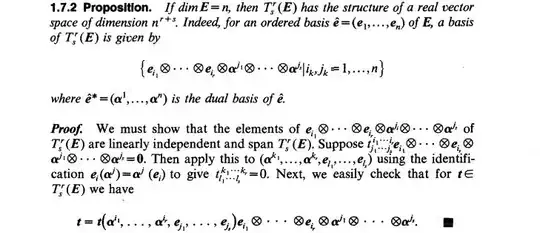In a nutshell: a proposition in Abraham's Foundations of Mechanics states that, given a vector space $E$ with basis $e_1,\ldots,e_n$, the space $T^r_s(E)$ of tensors of type $(r,s)$, the dual basis $\alpha^1,\ldots,\alpha^n$, we have that $$\{ e_{i_1}\otimes\dots\otimes e_{i_r}\otimes\alpha^{j_1}\otimes\dots\otimes\alpha^{j_s} : i_k,j_k = 1,\ldots,n\}$$ is a basis of $T^r_s(E)$.
I'm immediately confused as the tensor product is defined between tensors, and $e_{i_1},\ldots,e_{i_r}$ are vectors, not tensors. What is the meaning of the above set then?
The proposition (and its proof, in case that helps):
